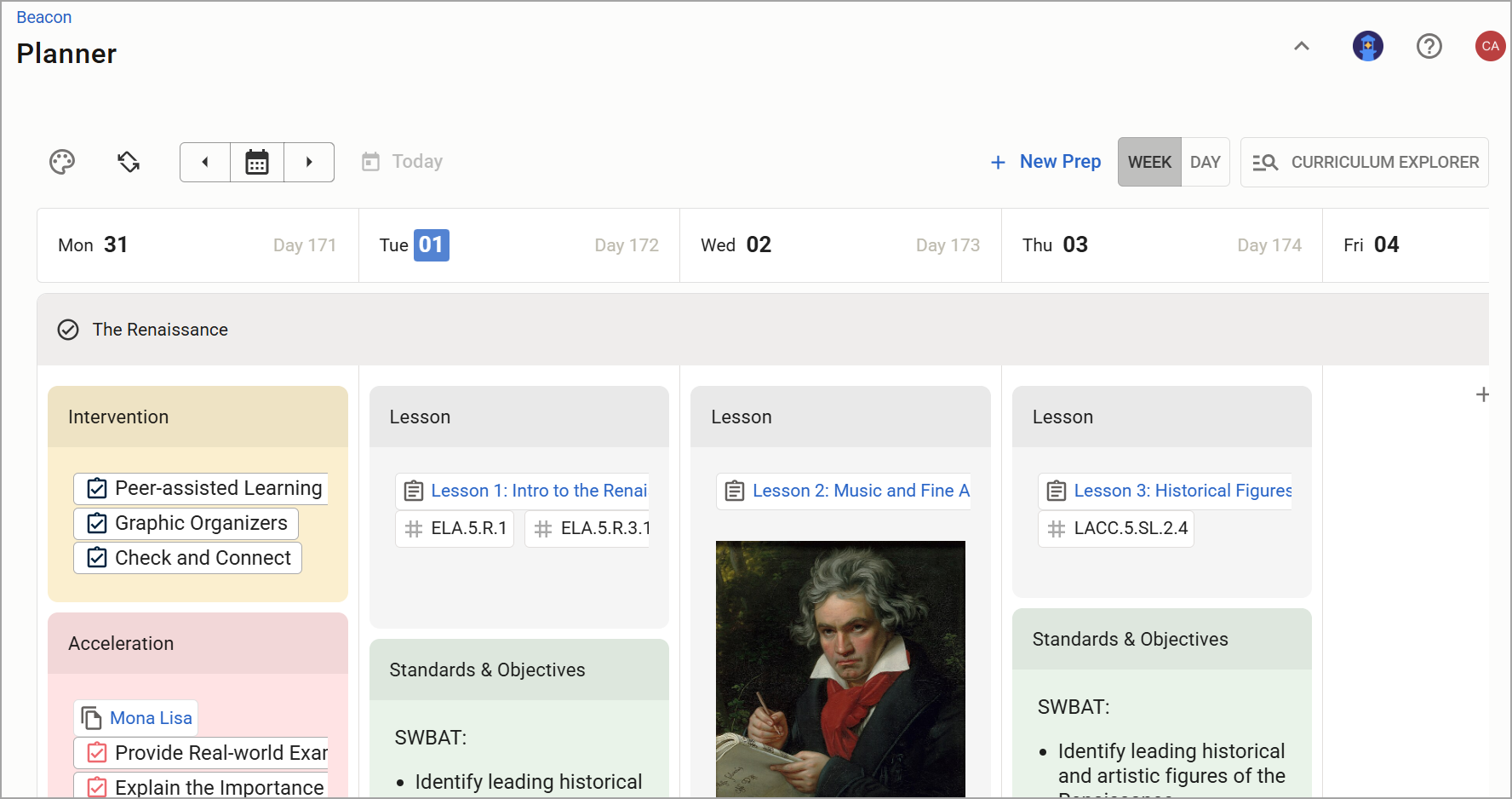Navigating the ever-changing world of education can be challenging, especially as resources and deliverables shift to digital formats, but there is a solution! Beacon is a comprehensive platform that streamlines curriculum management, lesson planning, and analysis, empowering educators with the tools they need to succeed.
With a robust content creation and management system, Beacon helps curriculum leaders build out high-quality content, measure its effectiveness, and support teachers in delivering impactful lessons. Teachers can strategize and collaborate in a central location, ensuring seamless communication and instruction within and across teams. With intuitive management of both local and third-party materials, Beacon also simplifies curriculum planning, and when paired with Aware, schools can align assessments with their curriculum, using real-time results to refine instruction.
Welcome to Beacon, your guiding light in the digital-first era of education!

Curriculum Components
Curriculum components are the building blocks that you use to construct your curriculum. Standards can be applied to any of the curriculum components.
Courses – A course is a structured program of instruction centered on a specific subject and grade level. An example of a course might be “7th Grade Math.” Courses are linked to complete standard sets and house curriculum components and content related to the standards, including units, lessons, and resources.
Units – A unit is a bundle of individual standards, a set of lessons, and resources. Each unit focuses on a specific topic, theme, or skill within a subject area. For example, the “7th Grade Math” course might contain a unit titled “Expressions, Equations, & Inequalities” that includes individual learning standards with a focus on these concepts. Units must be attached to courses and are accessed through the course in which they reside.
Lessons – A lesson is a single instructional session, usually housed within a unit, that focuses on a specific learning objective. For example, the “Expressions, Equations, & Inequalities” unit could have a lesson called “Using Equations to Solve Real World Problems.”
Resources – A resource is any additional content used to supplement courses, units, or lessons or used as a standalone tool to enhance the learning experience. It might be a PDF or image file, an instructional video, or other outside resources. It is primarily used as a means of direct instruction and student engagement. An example resource added to the “Using Equations to Solve Real World Problems” lesson is a YouTube Video that details problem-solving using equations.
Navigation
Beacon is comprised of these main screens:
My Planner - View your assigned classes and plans within the instructional calendar. Using the Curriculum Explorer, teachers can easily access all curriculum content needed to structure lessons for any grade, subject, or content area.
Courses - Create courses and link them to standard sets and house curriculum components related to the standards, including units, resources, and lessons.
Lessons - Easily search the list of all lessons that you have access to. You can also create or import new lessons from this screen.
Resources - Easily search the list of all resources that you have access to. You can also create or import new resources from this screen.
Templates - Create templates to help other users quickly create curriculum content, such as courses, units, lessons, and plans.
Strategies - Apply Strategies as tags to lessons and plans. For example, you might tag a lesson with a strategy to indicate that you applied certain accommodations, instructional strategies, or technology.
Scope and Sequence - Use the interactive Scope and Sequence tool to track standards coverage across preps.
Collaboration
Beacon is a collaborative platform, meaning that users can share materials with others and collaborate on creating and organizing curriculum content in real time. Such examples might include:
When a fourth-grade teacher shares their prep with other fourth-grade teachers at their school, they can equally contribute, linking helpful resources and staying on the same page.
When a tenth-grade History teacher shares resources with a tenth-grade ELA teacher, they can align instruction and help students make cross-disciplinary connections.
Curriculum leaders, mentors, or coaches can assist teachers in structuring and scheduling plans.
Visibility
Visibility settings determine who can see a curriculum component. There are three options for visibility settings:
District – A district curriculum component can be viewed by every user in the district and can only be edited by a user with the Create District Curriculum Courses right.
Shared – A shared curriculum component is a private component that has been shared with other users. Only the creator of the component and the specific users with whom it is shared can view the component.
Private – A private curriculum component can only be viewed, edited, or deleted by its creator unless it is shared with other users.
Sharing
Sharing settings determine the level of access that users have within the curriculum component and include the following options:
Owner – The Owner has full access to the curriculum component. The creator of a curriculum component is automatically assigned as an owner of it but can assign this role to someone else if necessary. You can assign multiple owners.
Contributor – A Contributor can edit the curriculum component, including adding other contributors and linking or unlinking child components. Contributors cannot add owners, change the visibility setting, or delete curriculum components.
Viewer – A Viewer can see everything within a curriculum component but cannot make any changes to the component.